Landmark decision: Brazil Supreme Court sides with Indigenous land rights
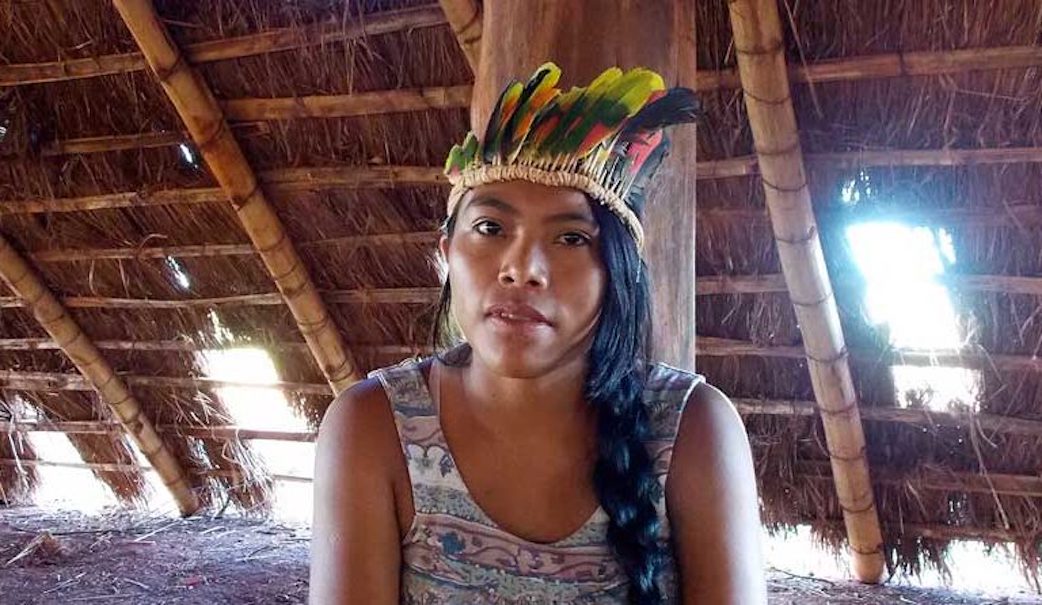
- Brazil’s Supreme Federal Court (STF) has unanimously accepted an appeal by the Guarani Kaiowá Indigenous people and agreed to review the process around a past case that cancelled the demarcation of their Indigenous territory.
- The Guarani Kaiowá’s decades-long fight for land rights to their ancestral territory, the Guyraroká land in Mato Grosso do Sul state, had been suspended by a 2014 ruling halting the territory’s demarcation process.
- The STF’s decision to review the process in the 2014 case, which hadn’t allowed for Indigenous consultation, is seen by analysts as a victory for Indigenous groups in Brazil, and as a setback for President Jair Bolsonaro who has declared his opposition to any Indigenous demarcation occurring during his administration.
- In a related upcoming case, the STF is expected to rule on the “marco temporal,” which requires that Indigenous people have been living on claimed lands in 1988 in order to establish a legal territory. But litigators have argued that date is unfairly arbitrary, as many Indigenous groups were forced off ancestral lands by then.
In a landmark decision that could bolster Indigenous land rights in Brazil and serve as a setback to the Bolsonaro administration’s stonewalling of demarcations, the country’s Supreme Court has agreed to review the process around a past case that cancelled the demarcation of an Indigenous territory claimed by the Guarani Kaiowá people.
In a unanimous decision last week, judges from the Supreme Federal Court (STF) accepted an appeal by the Guarani Kaiowá Indigenous people, whose decades-long fight for rights to the Guyraroká land was paralyzed by a 2014 ruling halting the territory’s demarcation process.
“This now paves the way for us to start the motion to annul that decision,” said Rafael Modesto dos Santos, legal advisor to the Indigenous Missionary Council (CIMI) and one of the lawyers for the Guyraroká community. “In other words, the process will start from zero. But before, we weren’t even allowed on the starting line.”

The Guyraroká territory, in the Brazilian state of Mato Grosso do Sul, was recognized as an Indigenous territory in 2004, and FUNAI, the federal agency tasked with protecting Indigenous interests, began the lengthy demarcation process in 2009.
But before the territory could gain full protected status under federal law, STF judges ruled that the Guarani Kaiowá had no legal claim to their ancestral territory because they were not living on it when the Brazilian constitution came into force in 1988.
The community tried to appeal the decision several times with no success, before the case was closed in 2016. But in last week’s ruling, the STF said the 2014 decision to throw out the demarcation process could be appealed and reviewed because the legal proceedings had lacked input from the Indigenous community.
While this latest STF ruling does not overturn the 2014 decision to scrap the territory’s demarcation, the reopening of the case marks a turning point and also sets an important precedent for other disputes over Indigenous lands in Brazil, according to Juliana de Paula Batista, a lawyer with the Instituto Socioambiental (ISA), a nonprofit that defends the rights of Indigenous and traditional people.
“It wasn’t just any victory, it was a victory by unanimous vote,” she told Mongabay. “All the judges agreed that, in a legal proceeding that harmed Indigenous people and did not give them the opportunity to participate, the proceeding must be annulled.”
“There is now a possibility for the judgement annulling the demarcation of Guyreroka to be overturned and another judgment to be handed down,” Batista said, adding that the ruling could also help other Indigenous groups who in the past weren’t allowed to participate in legal proceedings that revoked their land rights.

Last week’s decision is especially important within the current political context, in which signals by President Jair Bolsonaro have emboldened attacks on Indigenous land rights, according to Sarah Shenker, a campaigner with Survival International, an NGO that defends the rights of Indigenous people and has been working with the Guarani people for decades.
“With this war that is being waged on Brazil’s Indigenous people, it’s especially important that the Supreme Court has voted in favor of the Guarani and reminded everybody that Indigenous people have the right to a fair hearing,” Shenker said in an interview with Mongabay.
The Guyraroká territory at the center of the dispute sprawls across some 11,000 hectares (27,181 acres) of Mato Grosso do Sul, in Brazil’s agricultural heartland. A large part of the area being disputed by the Guyraroká is controlled by José Teixeira, a powerful politician and rancher.
The Guarani Kaiowá people say their land — part of Brazil’s vast tropical savanna biome known as the Cerrado — was stolen decades ago and turned into sugarcane plantations. The Indigenous families living on what they claimed as ancestral lands were forced into government reserves or pushed to the margins of nearby towns, according to Indigenous rights activists.
In 2000, a group of families returned to “re-occupy” a slice of the territory, setting up a makeshift village. Today, some 26 families remain on about 55 hectares (136 acres) of that territory, according to Shenker.
“These powerful ranchers are using the Guarani’s land,” she said. “And in the meantime, the Guarani are living in terrible conditions, in overcrowded reserves or on the sides of main roads or on tiny patches of their land, which they’ve tried to re-occupy.”

In 2013, the Guyraroká community’s leader Ambrósio Vilhalva was found dead just meters away from his home, a makeshift canvas shack in the occupied village. Police later said the murder was not connected to the local land dispute.
While the latest STF ruling has given the Guyraroká community new hope, there is no clear timeframe for when the case will move forward, Modesto dos Santos told Mongabay. “But we are confident that we will win.”
Legal experts say the Guyraroká case could be held up by another proceeding — a case involving the Xokleng Indigenous people in Santa Catarina state that also questions whether the government can deny land rights to Indigenous people whose territory was appropriated before 1988.
The STF ruling in that case — stalled since October 2020 — is expected to set a precedent that will decide whether the courts can place a time limit on the land rights of the Guarani Indigenous people — known as “marco temporal” in Portuguese.
Litigators have argued that the 1988 Indigenous occupation date is unfairly arbitrary, since many Indigenous groups had their ancestral lands stolen from them before that date and been forced off their lands.
“This is a process that will determine whether the “marco temporal” will be applicable to all Indigenous lands or not,” said Batista. “So we’re all watching closely.”
Opposition Wins Greenland Election After Running Against Rare Earths Mine
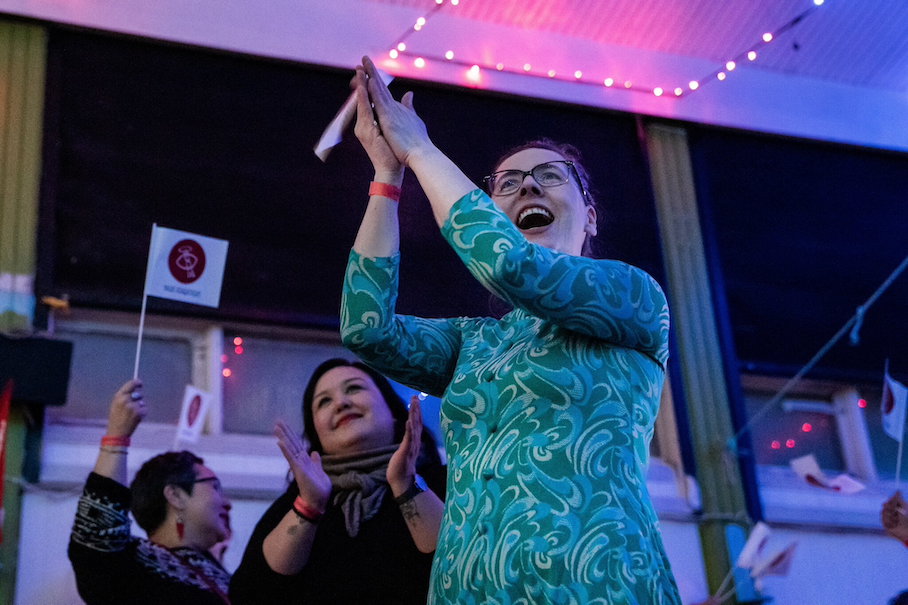
Greenland’s left-wing environmentalist party promised to halt a mining project that could have made Greenland a major source of rare earths but at a potentially steep environmental price.
Greenland’s left-wing environmentalist party, Inuit Ataqatigiit, won a victory in general elections on Tuesday after campaigning against the development of a contentious rare earths mine partly backed by China.
The party, which had been in the opposition, won 37 percent of the vote over the longtime incumbents, the center-left Siumut party. The environmentalists will need to negotiate a coalition to form a government, but observers said their election win in Greenland, a semiautonomous territory of Denmark that sits on a rich vein of untapped uranium and rare earth minerals, signaled concerns from voters over the impact of mining.
“The people have spoken,” Múte B. Egede, the leader of Inuit Ataqatigiit, told the Danish broadcaster DR, adding that voters had made their position clear and that the mining project in Kvanefjeld in the country’s south would be halted.
Greenland Minerals, an Australian company behind the project, has said the mine has the “potential to become the most significant Western world producer of rare earths,” adding that it would create uranium as a byproduct. The company did not immediately respond to requests for comment on the vote.
The supply of rare earths, a crucial part of the high-tech global supply chain and used in the manufacture of everything from cellphones to rechargeable batteries, is currently dominated by China. Shenghe Resources, a Chinese rare earth company, owns 11 percent of Greenland Minerals.
Opposition to the Greenland mine, which the incumbent Siumut party had supported, played a primary role in its defeat, its leader, Erik Jensen, conceded in an interview with the Danish station TV2.
The mining project has been in development for years, with the government approving drilling for research, but not issuing final approval for the mine.
Among Greenlanders, opposition to the mine had grown over potential exposure of a unique, fragile area to “radioactive pollution and toxic waste,” said Dwayne Menezes, the director of the Polar Research and Policy Initiative, a London-based think tank. “What they’re opposed to is dirty mining.”
The election result sent a clear message, Mr. Menezes added: Mining companies that want access to Greenland’s deposits will have to abide by stringent environmental standards and should look to give Greenlanders a “viable alternative.”
In Greenland, whose economy is heavily dependent on payouts from Denmark, the tensions over the mine centered on the potential economic boon, including hundreds of jobs on an island with about 57,000 people, versus the environmental cost of doing business.
But the vote also highlighted the Arctic region’s growing geopolitical significance on a warming planet, as its polar seas become more navigable and as the melting ice unveils newly accessible resources, including the rare earths that play an essential part in the production of many alternative energy sources.
“On a global level, we are going to need to address head on this tension between Indigenous communities and the materials we are going to most need for a climate-stressed planet,” said Aimee Boulanger, the executive director of the Initiative for Responsible Mining Assurance, a nonprofit.
Given China’s dominance over the global rare earth production and supply, Mr. Menezes said that Western countries should be looking for ways to enhance their partnerships with resource-rich Greenland to keep it in “their sphere of influence.”
Two years ago, Greenland’s lucrative resources and its increasing strategic importance led President Donald J. Trump to muse about purchasing the island. Greenland’s government, however, made clear that it was not for sale.
“We’re open for business, not for sale,” the island’s Ministry of Foreign Affairs posted on Twitter at the time.
Nordic countries set up Sámi reconciliation commissions to investigate indigenous injustices
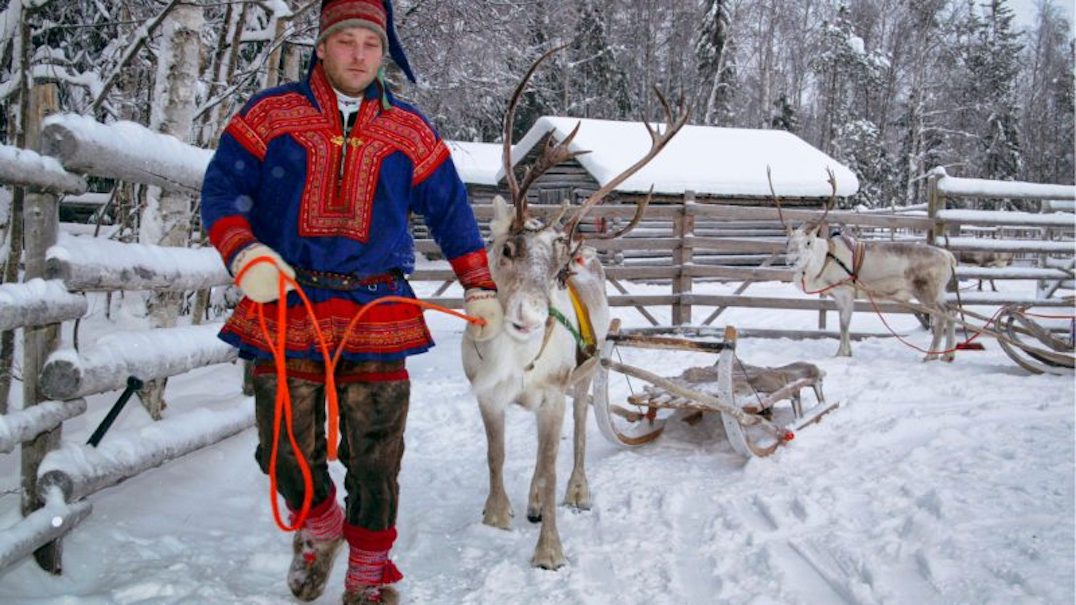
Colonial era policies in northern Scandinavia continue to affect Sámi life, culture and land use. Meanwhile, truth commissions are being set up and aim to investigate injustices against Indigenous people carried out by the states.
There are an estimated 100,000 to 150,000 Sámi in the Arctic regions, whose traditional homeland, an area collectively referred to as Sapmi, spans the Arctic regions of Norway, Sweden, Finland and the Kola Peninsula in Russia’s western Arctic.
From at least the 19th century, governments in Norway, Sweden, Finland and Russia pursued aggressive policies of assimilation, involving the education system and church discouraging or actively suppressing Sami languages and culture and forcibly assimilating Sami children into the dominant culture.
The Council of Europe and European human rights organisations have repeatedly condemned the lack of local representation of the Sámi in national governance decisions.
The process, Sámi representatives told EURACTIV, has negatively affected Sami languages, education and way of life until today.
But while the persecution of rights to culture and language have gradually ceased, climate change and land exploitation pose new threats to the existence of Sámi communities.
‘Truth commissions’
Sámi parliaments across Northern Europe have suggested the set-up of so-called truth commissions as one means of addressing systemic discrimination.
Inspired by Canada’s Truth and Reconciliation Commission, which completed its work in 2015, they are meant to include methods such as public hearings and “psychosocial support” for those who testify.
The Norwegian body was established in 2018, while the Finnish government agreed to the formation of a Truth and Reconciliation Commission in 2019 and the Sámi in Sweden started their work on a similar structure in 2020.
Russia, however, is lagging behind with attempts being made to silence critical indigenous voices in the country.
Most of the truth commissions are expected to take several years.
Asked what measures are needed to counteract ethnic discrimination of Sámi, Tuomas Aslak Juuso, President of the Finnish Sámi Parliament, told EURACTIV that the best tool is to focus on reminding Northern European countries of the need to observe human rights.
According to Juuso, “it is important to remind that human rights are a core part of democratic work, especially in Northern Europe, where maybe many people think that we are already human rights countries that are doing everything well in this domain.”
“That’s why we arrived at the need for the reconciliation commission – to recognise that there have been wrongdoings with dishonest colonial practices that are still impacting Sami people heavily,” he added.
One issue is a general lack of trust by Sámi people that the process will end with tangible improvements for their daily life.
“The majority population has been taught that they are an inferior, lower class of people,” a 2018 report prepared for the Finnish prime minister on the feasibility of a truth commission stated.
“They suspect that … the Finnish government is trying to improve its reputation internationally as a country that respects human rights … at the same time [as] it is further weakening the rights of the Sámi people,” the report added.
Getting a chance to understand the situation and educate the population of the home countries could contribute to “moving away from discrimination attitudes”, Juuso stressed.
“It’s important that governments show a willingness to commit to those rights, which have been promised and which they are obliged to fulfil,” Juuso told EURACTIV.
Europe’s closer look
As the EU works on updating its Arctic policy, which is due to be published by the end of this year, youth representatives from the European Arctic have called on policymakers to ensure that Arctic youth and Indigenous peoples are included in the actions that will directly affect their futures.
“Perhaps in the past, authorities, in general, have been guilty of paying lip service to the views of people who live in the Arctic, to indigenous peoples and also to young people,” Michael Mann, EU Special Envoy for Arctic Matters, told EURACTIV during a recent event.
Arctic stakeholders stressed that identity is of major importance to the young generation, who have “preserved Sámi language, culture and traditions, despite strong assimilation politics”.
“Sámi are threatened with losing their land due to renewable energy production such as windmill parks, mines and new infrastructure. Reindeer herding and industrial projects in traditional lands cannot coexist,” Enni Similä, chair of the Finnish Sámi Youth Association, said.
“We have been watching with interest the various lawsuits that have been going on in the Northern countries aimed at safeguarding these traditional lands and ways of life and in our policymaking,” the EU’s Arctic envoy said.
Indigenous peoples by far the best guardians of forests – UN report
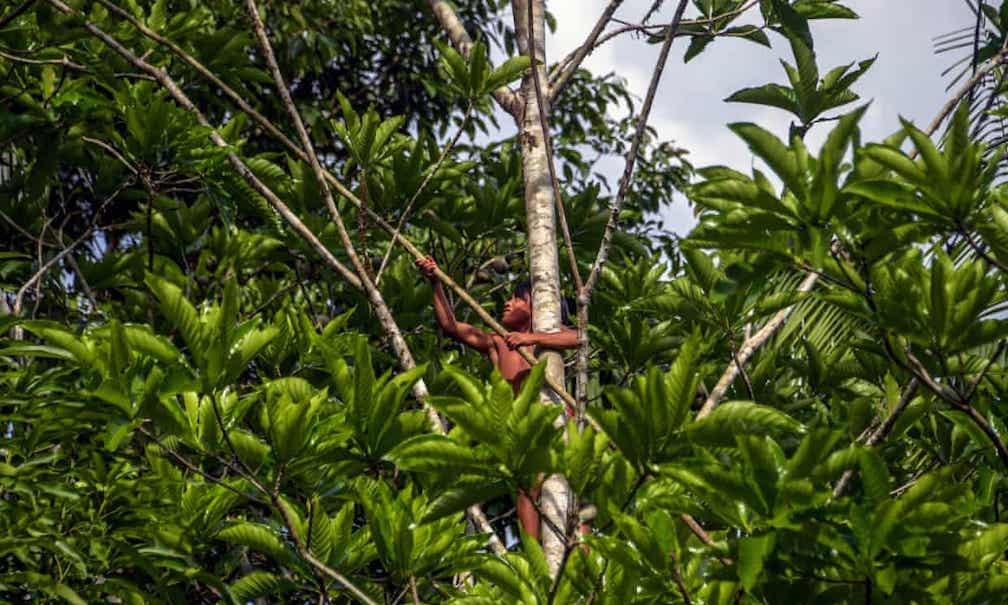
Preserving Latin America’s forests is vital to fight the climate crisis and deforestation is lower in indigenous territories
The embattled indigenous peoples of Latin America are by far the best guardians of the regions’ forests, according to a UN report, with deforestation rates up to 50% lower in their territories than elsewhere.
Protecting the vast forests is vital to tackling the climate crisis and plummeting populations of wildlife, and the report found that recognising the rights of indigenous and tribal peoples to their land is one of the most cost-effective actions. The report also calls for the peoples to be paid for the environmental benefits their stewardship provides, and for funding for the revitalisation of their ancestral knowledge of living in harmony with nature.
However, the demand for beef, soy, timber, oil and minerals means the threats to indigenous peoples and their forest homes are rising. Hundreds of community leaders have been killed because of disputes over land in recent years and the Covid-19 pandemic has added to the dangers forest peoples face.

Demands by indigenous peoples for their rights have become increasingly visible in recent years, the report said, but this has come with increasing persecution, racism, and assassinations. Supporting these peoples to protect the forests is particularly crucial now with scientists warning that the Amazon is nearing a tipping point where it switches from rainforest to savannah, risking the release of billions of tonnes of carbon into the atmosphere.
The report was produced by the UN Food and Agriculture Organization and the Fund for the Development of Indigenous Peoples of Latin America and the Caribbean (Filac), based on a review of more than 300 studies.This is my message to the western world – your civilisation is killing life on EarthNemonte NenquimoRead more
“Almost half of the intact forests in the Amazon basin are in indigenous territories and the evidence of their vital role in forest protection is crystal clear,” said the president of Filac, Myrna Cunningham, an indigenous woman from Nicaragua. “While the area of intact forest declined by only 5% between 2000 and 2016 in the region’s indigenous areas, in the non-indigenous areas it fell by 11%. This is why [indigenous peoples’] voice and vision should be taken into account in all global initiatives relating to climate change, biodiversity and forestry.”
“Indigenous peoples have a different concept of forests,” she said. “They are not seen as a place where you take out resources to increase your money – they are seen as a space where we live and that is given to us to protect for the next generations.”
Indigenous and tribal territories contain about a third of all the carbon stored in the forests of Latin America, said Julio Berdegué, the FAO’s Regional Representative: “These peoples are rich when it comes to culture, knowledge, and natural resources, but some of the poorest when it comes to incomes and access to services.” Supporting them would also help avoid new pandemics, he said, as these are most often the result of the destruction of nature.

“Even under siege from Covid-19 and a frightening rise in invasions from outsiders, we remain the ones who can stop the destruction of our forests and their biodiverse treasures,” said José Gregorio Diaz Mirabal, indigenous leader of an umbrella group, the Coordinator of the Indigenous Organizations of the Amazon Basin. He said the report’s evidence supports his call for climate funds to go directly to indigenous peoples and not governments vulnerable to corruption.
The report found the best forest protection was provided by peoples with collective legal titles to their lands. A 12-year study in the Bolivian, Brazilian, and Colombian Amazon found deforestation rates in such territories were only one half to one-third of those in other similar forests. Even though indigenous territories cover 28% of the Amazon Basin, they only generated 2.6% of the region’s carbon emissions, the report said.
Indigenous peoples occupy 400m hectares of land in the region, but there is no legal recognition of their property rights in a third of this area. “While the impact of guaranteeing tenure security is great, the cost is very low,” the report said, needing less than $45 per hectare for the mapping, negotiation and legal work required.
The report said it would cost many times more to prevent carbon emissions from fossil fuel burning using carbon capture and storage technology on power plants. The granting of land rights to indigenous people has increased over the last 20 years, Cunningham said, but has slowed down in recent years.
Paying indigenous and tribal communities for the environmental services of their territories has reduced deforestation in countries including Ecuador, Mexico, and Peru. Berdegué said such programmes could attract hundreds of millions of dollars per year from international sources.
The need for protection is urgent, the report said, with annual deforestation rates in Brazil’s indigenous territories rising from 10,000 hectares in 2017 to 43,000 hectares in 2019. In January, indigenous leaders urged the international criminal court to investigate Brazil’s president, Jair Bolsonaro, over his dismantling of environmental policies and violations of indigenous rights.
Elsewhere, the area of large intact forests in indigenous territories has fallen between 2000 and 2016, with 59% lost in Paraguay, 42% in Nicaragua, 30% in Honduras and 20% in Bolivia. Mining and oil concessions now overlay almost a quarter of the land in Amazon basin indigenous and tribal territories, the report said.
There’s a Global Plan to Conserve Nature. Indigenous People Could Lead the Way.
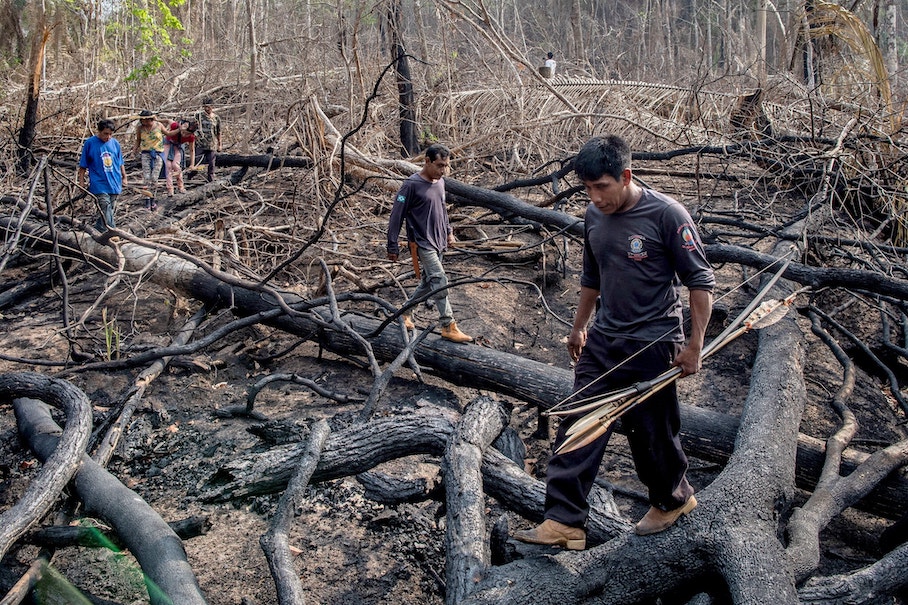
Dozens of countries are backing an effort that would protect 30 percent of Earth’s land and water. Native people, often among the most effective stewards of nature, have been disregarded, or worse, in the past.
With a million species at risk of extinction, dozens of countries are pushing to protect at least 30 percent of the planet’s land and water by 2030. Their goal is to hammer out a global agreement at negotiations to be held in China later this year, designed to keep intact natural areas like old growth forests and wetlands that nurture biodiversity, store carbon and filter water.
But many people who have been protecting nature successfully for generations won’t be deciding on the deal: Indigenous communities and others who have kept room for animals, plants and their habitats, not by fencing off nature, but by making a small living from it. The key to their success, research shows, is not extracting too much.
In the Brazilian Amazon, Indigenous people put their bodies on the line to protect native lands threatened by loggers and ranchers. In Canada, a First Nations group created a huge park to block mining. In Papua New Guinea, fishing communities have set up no-fishing zones. And in Guatemala, people living in a sprawling nature reserve are harvesting high-value timber in small amounts. In fact, some of those logs could end up as new bike lanes on the Brooklyn Bridge.
“If you’re going to save only the insects and the animals and not the Indigenous people, there’s a big contradiction,” said José Gregorio Díaz Mirabal, who leads an umbrella group, the Coordinator of Indigenous Organizations of the Amazon River Basin. “We’re one ecosystem.”
Nature is healthier on the more than quarter of the world’s lands that Indigenous people manage or own, according to several scientific studies. Indigenous-managed lands in Brazil, Canada and Australia have as much or more biodiversity than lands set aside for conservation by federal and other governments, researchers have found.
That is in stark contrast from the history of conservation, which has a troubled record of forcing people off their land. So, it is with a mixture of hope and worry that many Indigenous leaders view this latest global goal, known as 30×30, led by Britain, Costa Rica and France. Some want a higher target — more than 50 percent, according to Mr. Díaz Mirabal’s organization — while others fear that they may once again be pushed out in the name of conservation.
Defending Land, Protecting Vital Forests
In the Brazilian Amazon, Awapu Uru Eu Wau Wau puts his life on the line to protect the riches of his ancestral lands: jaguars, endangered brown woolly monkeys, and natural springs from which 17 important rivers flow. His people, the Indigenous Uru Eu Wau Wau, have legal right to the land, but must constantly defend it from armed intruders.
Just beyond their 7,000-square mile territory, cattle ranchers and soy planters have razed much of the forest. Their land is among the last protected forests and savanna left in the Brazilian state of Rondônia. Illegal loggers often encroach.


So Mr. Uru Eu Wau Wau, who uses his community’s name as his surname, patrols the forest with poison-tipped arrows. Others in his community keep watch with drones, GPS equipment and video cameras. He prepares his daughter and son, 11 and 13 years old, to defend it in the years ahead.
“No one knows what’s going to happen to us, and I’m not going to live forever,” Mr. Uru Eu Wau Wau said. “We need to leave it to our children to get on with things.”
The risks are high. Mr. Uru Eu Wau Wau’s cousin, Ari Uru Eu Wau Wau, was murdered last April, part of a chilling pattern among land defenders across the Amazon. In 2019, the most recent year for which data is available, at least 46 were murdered across Latin America. Many were Indigenous.
The community’s efforts have outsized benefits for the world’s 7.75 billion people: The Amazon, which accounts for half the remaining tropical rainforest in the world, helps to regulate Earth’s climate and nurtures invaluable genetic diversity. Research shows Indigenous property rights are crucial to reducing illegal deforestation in the Amazon.
A Collapse of Nature
Nature is under assault because humans gobble up land to grow food, harvest timber and dig for minerals, while also overfishing the oceans. Making matters worse, the combustion of fossil fuels is warming up the planet and making it harder for animals and plants to survive.
At fault, some scholars say, are the same historical forces that have extracted natural resources for hundreds of years, at the expense of Indigenous people. “What we’re seeing now with the biodiversity collapse and with climate change is the final stage of the effects of colonialism,” said Paige West, an anthropologist at Columbia University.
There is now broad recognition that reversing the loss of biodiversity is urgent not only for food security and a stable climate, it’s also critical to reducing the risk of new diseases spilling over from wild animals, like the coronavirus.


Enter 30×30. The goal to protect at least 30 percent of the Earth’s land and water, long pushed by conservationists, has been taken up by a coalition of countries. It will be part of diplomatic negotiations to be held in Kunming, China, this fall, under the United Nations Convention on Biodiversity. The United States is the only country, apart from the Vatican, that has not joined the convention, though President Biden has ordered up a plan to protect 30 percent of American waters and lands.
Indigenous communities are not recognized as parties to the international agreement. They can come as observers to the talks, but can’t vote on the outcome. Practically though, success is impossible without their support.
They already protect much of the world’s land and water, as David Cooper, deputy executive secretary of the United Nations agency for biodiversity, pointed out. “People live in these places,” he said. “They need to be engaged and their rights respected.”
A coalition of Indigenous groups and local communities has called for the agreement to protect at least half of the planet. Scientific research backs them up, finding that saving a third of the planet is simply not enough to preserve biodiversity and to store enough planet-warming carbon dioxide to slow down global warming.
Creating a New Kind of Park
A half century ago, where boreal forest meets tundra in Canada’s Northwest Territories, the Łutsël K’é’ Dene, one of the area’s Indigenous groups, opposed Canada’s efforts to set up a national park in and around its homeland.
“At that time, Canada’s national parks policies were very negative to Indigenous people’s ways of life,” said Steven Nitah, a former tribal chief. “They used to create national parks — fortress parks, I call it — and they kicked people out.”
But in the 1990s, the Łutsël K’é’ Dene faced a new threat: Diamonds were found nearby. They feared their lands would be gutted by mining companies. So they went back to the Canadian government to revisit the idea of a national park — one that enshrined their rights to manage the land, hunt and fish.


“To protect that heart of our homeland from industrial activities, this is what we used,” said Mr. Nitah, who served as his people’s chief negotiator with the Canadian government.
The park opened in 2019. Its name, Thaidene Nëné, means “Land of the Ancestors.”
Collaboration among conservationists, Indigenous nations and governments holds a key to protecting biodiversity, according to research.
Without local support, creating protected areas can be useless. They often fail to conserve animals and plants, becoming so-called “paper parks.”
Making a Living From Nature
Researchers have found that biodiversity protection often works best when local communities have a stake.
On islands in Papua New Guinea, for example, where fish is a staple, stocks had dwindled in recent decades. Fishers ventured farther from shore and spent more time at sea, but came back with smaller catches. So they partnered with local and international nonprofit groups to try something new. They changed their nets to let smaller fish escape. They reduced their use of a poison that brings fish to the surface. Most critically, they closed some waters to fishing altogether.
Meksen Darius, the head of one of the clans using these measures, said people were open to the idea because they hoped it would improve their livelihoods.
It did.
“The volume, the kinds of species of fish and other marine life, they’ve multiplied,” Mr. Darius, a retired lawyer, said.
Recent research from around the world shows that marine protected areas increase fish stocks, ultimately allowing fishing communities to catch more fish on the edges of the reserves.


To Iliana Monterroso, an environmental scientist at the Center for International Forestry Research in Lima, Peru, what matters is that people who live in areas of high biodiversity have a right to manage those areas. She pointed to the example of the Mayan Biosphere Reserve, a territory of two million hectares in Guatemala, where local communities have managed the forest for 30 years.
Under temporary contracts with the national government, they began harvesting limited quantities of timber and allspice, selling ornamental palms and running tourism agencies. They had an investment to protect. “The forest became the source of livelihood,” Dr. Monterroso said. “They were able to gain tangible benefits.”
Jaguars, spider monkeys and 535 species of butterflies thrive there. So does the white-lipped peccary, a shy pig that tends to disappear quickly when there’s hunting pressure. Community-managed forests have fewer forest fires, and there is almost zero rate of deforestation, according to researchers.
Erwin Maas is among the hundreds of Guatemalans who live there, too. He and his neighbors run a community-owned business in the village of Uaxactún. Mahogany is plentiful, but they can take only so much. Often, it’s one or two trees per hectare per year, Mr. Maas said. Seed-producing trees are left alone.
“Our goal is to sustain ourselves with a small amount and always take care of the forest,” he said.
Indigenous Leaders and Goldman Prize Recipients Send Open Letter Demanding BlackRock Act on Deforestation and Human Rights
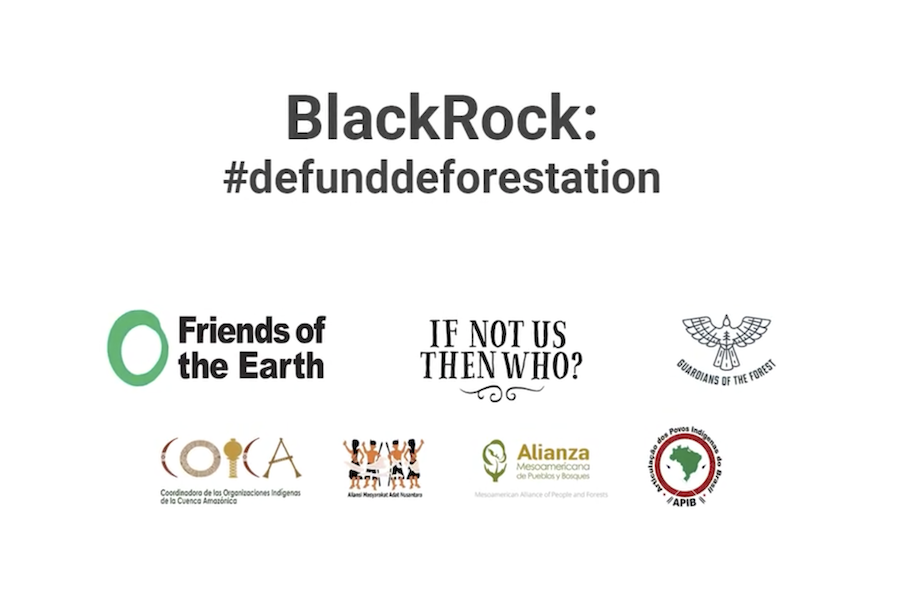
BlackRock has yet to produce concrete policy addressing land rights, deforestation, and human rights abuses in its portfolios
Today, over 80 renowned Indigenous and frontline activists from around the world issued a public letter criticizing BlackRock’s role in violating the land rights and human rights of Indigenous peoples and other traditional communities. The signatories, including several recipients of the prestigious Goldman Environmental Prize, point to BlackRock’s continued large-scale investments in fossil fuel and deforestation-linked companies that violate human rights, and demand that the asset manager cease these investments.
Eloy Terena, Legal Coordinator of the Association of Brazil’s Indigenous Peoples (APIB), and one of the letter’s signers said: “BlackRock’s investments have an impact on our lives and our communities, and the company’s leadership, therefore, has a responsibility for our future. If the Amazon is destroyed, the future of the entire planet is at risk.”
Last week, BlackRock released a memo on “natural capital”, a memo on human rights impacts, and updated engagement priorities. In these memos BlackRock encouraged the companies it invests in to adopt “no deforestation” policies, to account for biodiversity in their operations, and to obtain the free, prior and informed consent (FPIC) of indigenous peoples “for initiatives that affect their rights.”
Despite the urgency of these issues, BlackRock did not lay out any clear accountability mechanisms to assure that its “engagement” results in concrete improvements for communities, ecosystems, and the planet in these new memos. But this new acknowledgment is a step in the right direction that comes after years of campaigning by Indigenous leaders and civil society organizations demanding that BlackRock take responsibility for its role in deforestation and human and Indigenous rights violations.
Sonia Guajajara, Executive Coordinator of the Association of Brazil’s Indigenous Peoples (APIB), said, “Despite its latest announcement on ‘natural capital,’ BlackRock does not have a concrete policy in place to handle investments that impact Indigenous peoples and our territories. BlackRock has not pledged to pressure companies to end deforestation in the Amazon. Our challenge to BlackRock is clear: safeguard Indigenous peoples’ rights and eliminate deforestation and human rights violations from its portfolios.”
Today’s letter outlines the urgent need for action, stating: “While BlackRock makes pledges to ask portfolio companies to cut emissions in the future, our forests are being razed, our land is being stolen, and our people are being killed, today.”
Despite BlackRock’s January commitment to achieve net-zero by 2050, the asset manager has, according to the letter, done “little to ensure [its] investments respect human rights, land rights, and the self-determination of Indigenous and local communities.” BlackRock remains one of the largest investors in the two biggest drivers of the climate crisis: fossil fuels and industrial agricultural commodities linked to deforestation, such as palm oil, soy, cattle, pulp, and paper. These industries regularly violate the rights of Indigenous and local communities. BlackRock has no policies in place that address deforestation, human rights, or land rights.
The signers of today’s letter hail from some of the world’s most sensitive biomes, including the Amazon and the rainforests of Indonesia and West Africa. They write that it is not just their land, homes, and cultures that are at stake, but their lives.
Goldman Prize recipient Alfred Brownell, Liberian human rights and environmental lawyer, who was forced to flee his country after threats to his life, said: “I am quite surprised that Mr. Fink and BlackRock have not yet responded to my 2019 letter. The agribusiness companies BlackRock finances in Liberia’s Upper Guinea Forest are not only destroying the precious habitat of endangered pygmy hippos and chimpanzees, they are dispossessing my people of their land and the right to choose their own model of development. Instead of adding value to community-driven enterprises that coexist with nature, BlackRock’s investments are obliterating shrines and burial grounds and wiping out centuries of history, culture, religion, customs, and values that indigenous communities hold sacred, further impoverishing indigenous communities.”
In April 2019, Brownell publicly charged BlackRock with financing palm oil companies destroying the lands, livelihoods, and cultural sites of Liberian communities. A month later, Indigenous leaders from the Amazon, including Mr. Terena, confronted CEO Larry Fink at BlackRock’s annual general meeting in New York for the firm’s support of companies complicit in widespread forest fires.
“Communities around the world are facing an epidemic of violence, murder, and criminalization at the hands of extractive industries. In 2019, more than four land and environmental defenders were murdered each week for protecting their traditional lands. Frontline communities and activists are often the first responders to the destructive – and deadly – impacts of the climate crisis as they confront companies that destroy forests, pollute water sources, and drive species into extinction,” the letter states.
Deb Haaland Becomes First Native American Cabinet Secretary
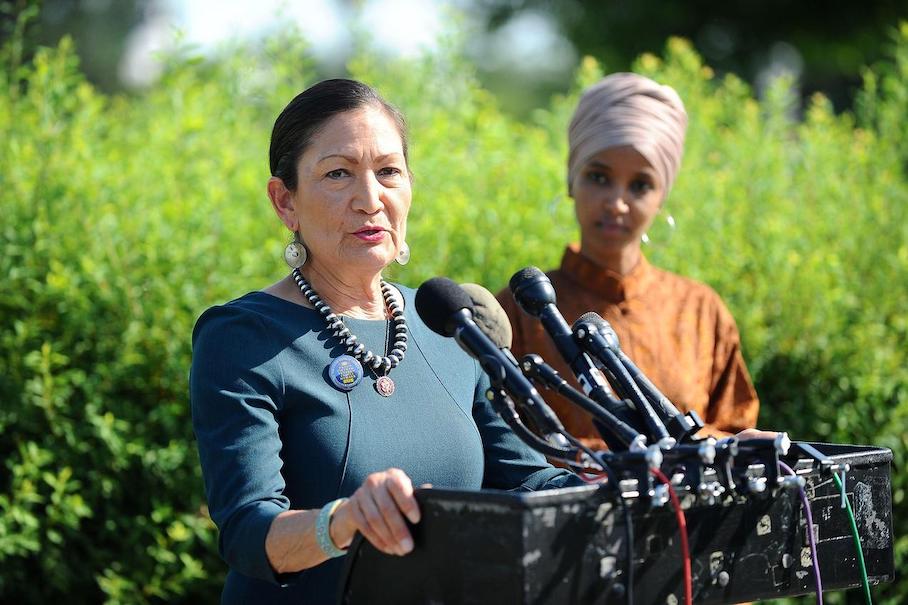
The Senate confirmed Ms. Haaland to lead the Interior Department. She’ll be charged with essentially reversing the agency’s course over the past four years.
WASHINGTON — Representative Deb Haaland of New Mexico made history on Monday when the Senate confirmed her as President Biden’s secretary of the Interior, making her the first Native American to lead a cabinet agency.
Ms. Haaland in 2018 became one of the first two Native American women elected to the House. But her new position is particularly redolent of history because the department she now leads has spent much of its history abusing or neglecting America’s Indigenous people.
Beyond the Interior Department’s responsibility for the well-being of the nation’s 1.9 million Native people, it oversees about 500 million acres of public land, federal waters off the United States coastline, a huge system of dams and reservoirs across the Western United States and the protection of thousands of endangered species.
“A voice like mine has never been a Cabinet secretary or at the head of the Department of Interior,” she wrote on Twitter before the vote. “Growing up in my mother’s Pueblo household made me fierce. I’ll be fierce for all of us, our planet, and all of our protected land.”
Republican opposition to her confirmation centered on Ms. Haaland’s history of fighting against oil and gas exploration, and the deliberations around her nomination highlighted her emerging role in the public debates on climate change, energy policy and racial equity. She was confirmed on a 51-40 vote. Only four Republican senators — Lisa Murkowski and Dan Sullivan of Alaska, Susan Collins of Maine and Lindsey Graham of South Carolina — voted for Ms. Haaland’s confirmation.
Senator Mitch McConnell of Kentucky, the Republican leader, said supporting her confirmation “would be voting to raise gas prices for families who are already struggling, to raise fuel and heating bills for seniors on a fixed income, to take the tough times we’ve been going through and make them even tougher.”
The new interior secretary will be charged with essentially reversing the agency’s mission over the past four years. The Interior Department, led by David Bernhardt, a former oil lobbyist, played a central role in the Trump administration’s systematic rollback of environmental regulations and the opening up of the nation’s lands and waters to drilling and mining.
Ms. Haaland is expected to quickly halt new drilling, reinstate wildlife conservation rules, rapidly expand wind and solar power on public lands and waters, and place the Interior Department at the center of Mr. Biden’s climate agenda.
At the same time, Ms. Haaland will quite likely assume a central role in realizing Mr. Biden’s promise to make racial equity a theme in his administration. Ms. Haaland, a member of the Laguna Pueblo who identifies herself as a 35th-generation New Mexican, will assume control of the Bureau of Indian Affairs and the Bureau of Indian Education, where she can address the needs of a population that has suffered from abuse and dislocation at the hands of the United States government for generations, and that has been disproportionately devastated by the coronavirus.

“You’ve heard the Earth referred to as Mother Earth,” Ms. Haaland said at her Senate confirmation hearing. “It’s difficult to not feel obligated to protect this land. And I feel every Indigenous person in the country understands that.”
Lynn Scarlett, who served as deputy interior secretary under George W. Bush and is now a senior official at the Nature Conservancy, warned, “It’s an enormous job, an enormously complex job.”
“The Interior Department has a footprint in all 50 states,” she said. “Its policies touch each and every American.”
As the agency takes on a newly muscular role in addressing climate change, she added, the department “will have to deal with new strategies for managing more intense wildfires on public land and chronic drought in the West. It’s hard to overstate the challenges with water.”
Among the first and most contentious items on Ms. Haaland’s to-do list will be enacting Mr. Biden’s campaign pledge to ban new permits for oil and gas projects on public lands.
Already, the White House has placed a short-term halt on issuing new oil and gas leases on public lands, which has drawn fierce attacks from Republicans and the oil and gas industry.
Ms. Haaland’s ability to implement that ban successfully could have major consequences both for the climate and for the Biden administration. According to one study by Interior Department scientists, the emissions associated with fossil fuel drilling on public lands account for about a quarter of the nation’s greenhouse gases. But the policy will most likely be enacted at a time when gasoline prices are projected to soar — spurring almost-certain political blowback from Republicans ahead of the 2022 midterm elections.
For the drilling ban to survive legal challenges, experts say, Ms. Haaland will have to move with care.
“They may attempt a total ban, but that would be more vulnerable to a court challenge,” said Marcella Burke, an energy policy lawyer and former Interior Department official. “Or there’s the ‘death by a thousand cuts’ approach.”
That approach would make oil drilling less feasible by creating such stringent regulations and cleanup rules that exploration would not be worth the cost.
“Each step will be challenged in the courts, but it’s like diversifying your portfolio,” Ms. Burke said. “It lowers the risk that one single ban will be thrown out in courts.”
Complicating Ms. Haaland’s efforts to formulate new land management policies will be a logistical hurdle: the planned relocation of the Bureau of Land Management, an agency within the Interior Department that oversees oil and gas drilling policies. The bureau is expected to move back to Washington from Grand Junction, Colo., where it was moved by the Trump administration.
“You need to move that back to D.C. and build it back,” said Joel Clement, a former Interior Department expert in climate change policy who resigned from the agency in protest of the Trump administration policies. “The staff, the budget — all these people who were supposed to work with Congress on these policies were pushed out West, or they left,” he said. “They are hugely demoralized.”
Ms. Haaland is also expected to revisit the Trump administration’s rollback of habitat protections under the Endangered Species Act. Under the Trump rules, it became easier to remove a species from the endangered list, and for the first time, regulators were allowed to conduct economic assessments — for instance, estimating lost revenue from a prohibition on logging in a critical habitat — when deciding whether a species warrants protection.
Such rules led to an exodus of staff, particularly from the Fish and Wildlife Service, Mr. Clement said.
“There’s a rebuilding that needs to happen there,” he said.
The Interior Department also must submit a detailed new plan by June 2022 that lays out how the federal government will manage the vast outer continental shelf off the American coastline, an area rich in marine wilderness and undersea oil and gas resources.
Given Mr. Biden’s pledge to ban new drilling, the new offshore management plan will quite likely reimpose Obama-era policies that barred oil exploration on the entire East and West Coasts of the United States — while possibly going further, by limiting drilling off the coasts of Alaska and in the Gulf of Mexico. But writing the legal, economic and scientific justifications will be difficult.
“They have to get started and really get cracking,” said Jacqueline Savitz, a vice president of Oceana, an environmental group.
As the department moves against offshore drilling, it is expected to help ramp up offshore wind farms. Last week, the agency took a major step toward approving the nation’s first large-scale offshore wind farm, near Martha’s Vineyard, Mass., a project that had been in the works for years.
“This administration is in a position to make large-scale offshore wind a reality for the first time,” Ms. Savitz said. “But the transition in the ocean from offshore fossil fuels to wind farms needs to happen in the next four years, so it’s in place before the next administration.”
Indigenous peoples call on Nornickel’s global partners to demand environmental action
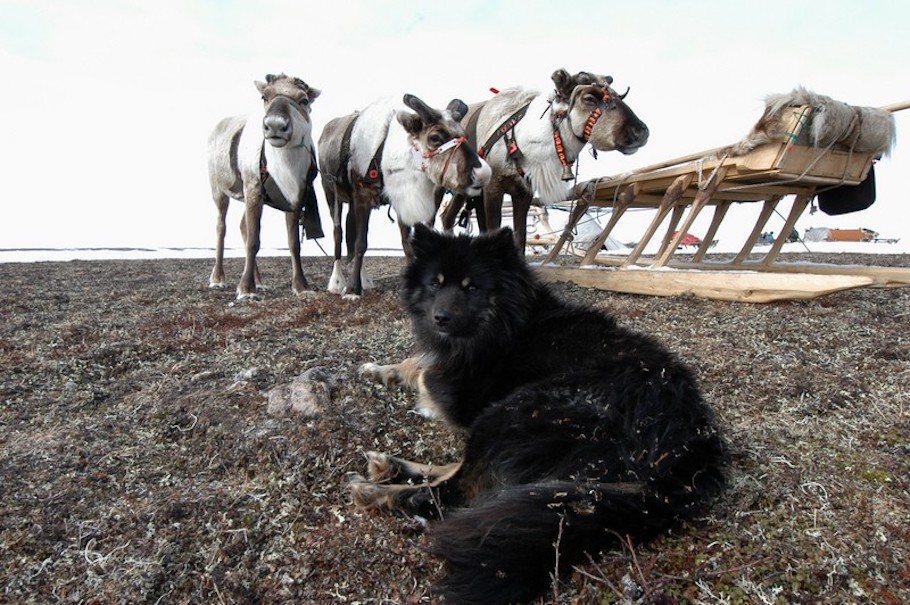
Nornickel does not invite us to meetings, so now we urge international shareholders and buyers of their metals to take action, says Pavel Sulyandziga, President of the Batani Foundation, an exile group working for the rights of indigenous peoples in the Russian north.
Nornickel’s multibillion-dollar worth mining- and metallurgical plants on the Siberian tundra are key to deliver metals for the electromobility industry. The company produces one third of the global supply of nickel and has some of the largest factories in the world for copper and cobalt.
All three metals are in growing demand as Europe, Asia and North America try to catch up in global battery race.
In Russia, however, the scramble for metals come with a cost. Pollution from the factories in Norilsk has for decades ranked top in global air pollution and a recent oil spill caused anger all the way to President Putin’s office.
Nornickel claims it has environment as a top priority, with comprehensive plans to further reduce air pollution.
That priority is questioned by indigenous peoples who feel they are taking to a wall.
“No, Nornickel does not invite to meetings and conferences,” said Pavel Sulyandziga when asked by the Barents Observer about his indigenous group’s dialog with the metallurgical giant.
“They are used to dictate conditions to everyone in Russia. In Taimyr, Nornickel is the Tsar and the God at the same time,” he said.
Sulyandziga is President of Batani Foundation, an international fund created to support indigenous peoples in the Russian north. The group’s help to communities protesting mineral extraction and industrial pollution on indigenous land has always been a thorn in the eye of authorities. The Russian government declared Batani Foundation as a foreign agent in 2015 and two years later, the organization was liquidated by the Moscow city court after a demand from the Ministry of Justice.
Since then, the group has worked in exile, with staff members asking asylum in the United States, Norway and Sweden.
Critical questions excluded
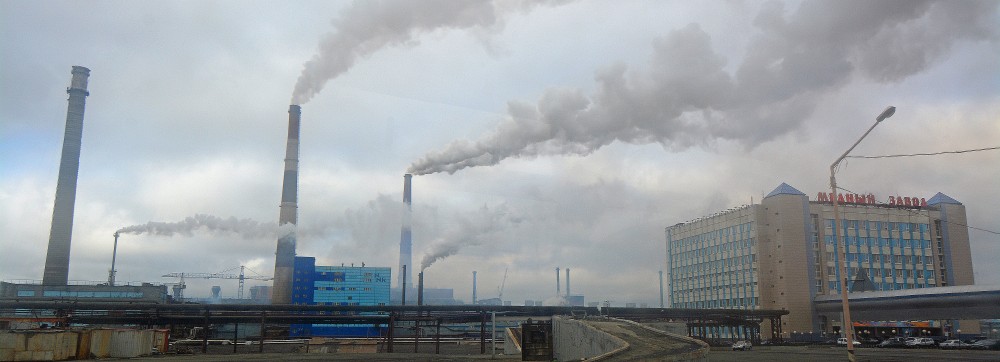
Sulyandziga claims Nornickel brings in only those indigenous peoples who can paint a “beautiful picture” of the company’s activities.
“Those who ask inconvenient questions, about various violations and problems, are simply excluded.”
Together with 35 other organizations and entities working with indigenous peoples rights and environment, the Batani Foundation has sent an urgent call to both international banking and credit institutions and buyers of metals from Nornickel.
One of the receivers of the letter is BASF, the world’s largest chemical producer and a leading producer of material to electric vehicle’s battery production.
“Given the increasing level of ethical and environmental scrutiny that is being brought to bear on supply chains for battery nickel, it is imperative that BASF does not fall foul of investor sentiment. For BASF’s Group Position and Supplier Code of Conduct to have credibility, BASF must take action to address Nornickel’s violations,” the letter reads and lists numerous examples of environmental misconduct by Nornickel in the Russian Arctic region.
Pavel Sulyandziga hopes external pressure from global customers will help.
“Nornickel only understands money. If BASF makes it clear to Nornickel that it is necessary to change its policies and attitudes, this will encourage Nornickel to actually pursue a policy of respect for the rights of indigenous peoples in accordance with international standards,” Sulyandziga said.
He adds: “We want to see this change in reality, not in presentations.”
“Sustainability matters”
Christine Haupt, spokesperson for BASF, assures to the Barents Observer that the company expect all suppliers “to fully comply with applicable laws and to follow internationally recognized environmental, social and corporate governance standards.”
She said BASF is in regular contact with Nornickel on sustainability matters and other aspects relevant to cooperation.
It was in 2018, BASF and Nornickel established a strategic cooperation to meet the growing needs for battery materials in electric vehicles. The cooperation includes construction of a new plant for battery material production serving the European automotive market in adjacent to the nickel and cobalt refinery owned by Nornickel in Harjavalta in Finland.
“What counts in our view, based on the UN Guiding Principles on Business and Human Rights, are the willingness and actins of a company to work towards sustainability,” said Christine Haupt.
She said BASF is co-founder of the Global Battery Alliance, which brings together business, government and civil society to develop standards and tolls to create a social responsible, ecological and economically sustainable, and innovative value chain for batteries.
BASF, though, is only one of many scrambling for battery metals.
Tesla’s Elon Must last year called on miners to produce more nickel. “Tesla will give you a giant contract for a long period of time if you mine nickel efficiently and in an environmental sensitive way.”
Other carmakers, like Hyundai, GM, Ford and Nissan, are all rushing to secure raw materials for battery cars believed to count for tens of millions of new vehicles annually within the next few years.
Support program

Well aware of the critical voices, Nornickel this week announced a grant support program to the indigenous peoples of Taimyr where the company’s largest metallurgical factories are located in Norilsk.
“Most of the applications are aimed at preserving long-term traditions and practices, historical memory and cultural code of the peoples of Taimyr. We hope that the World of Taimyr competition will become a real support for local communities, help not only preserve, but also develop the rich cultural heritage of the region, ”said Larisa Zelkova, senior vice president of Nornickel.
Pavel Sulyandziga said this is just an example of Nornickel buying influence.
“Why would they negotiate with those they cannot influence when they can simply buy the loyalty of others,” he said.
“This is the Russian reality,” Sulyandziga added.
Financial institutions
The Batani Foundation, the Aborigine Forum and the Society for Threatened Peoples questions in a joint letter to UBS Switzerland this week why the multinational investment bank continuously finances Nornickel, “despite its widely known failure in environmental and human rights issues.
The Union Bank of Switzerland is, according to the organizations, holding shares and bonds in the value of $34 million and for underwriting activities in the value of $63 millions.
Another Swiss banking company, Credit Suisse, is in a similar letter asked about what they are doing to ensure their investments with Nornickel does not violate the rights of the indigenous peoples in the Russian north and what is done to prevent further environmental damage.
Credit Suisse acquired shares in the amount of $184 million in 2019 and provided loans to Nornickel, according to the indigenous peoples’ NGOs.
The letter to Credit Suisse details how the indigenous peoples of the Arctic who have occupied the land for generations, like the Sámi, Nenets, Nganasan, Enets, Dolgan and Evenk communities, suffer as a result of Nornickel’s negative impacts on their herding, hunting, fishing, and overall economic and subsistence activities, as well as their physical health and well-being.
In 2009, the Norwegian Pension Fund, one of the world’s largest investors, blacklisted Nornickel due to “severe environmental damage”. Later, other financial institutions like Actiam and Skandia followed.
Senate Committee Votes To Confirm Haaland. Here’s Who Voted For and Against Her and What Happens Next.
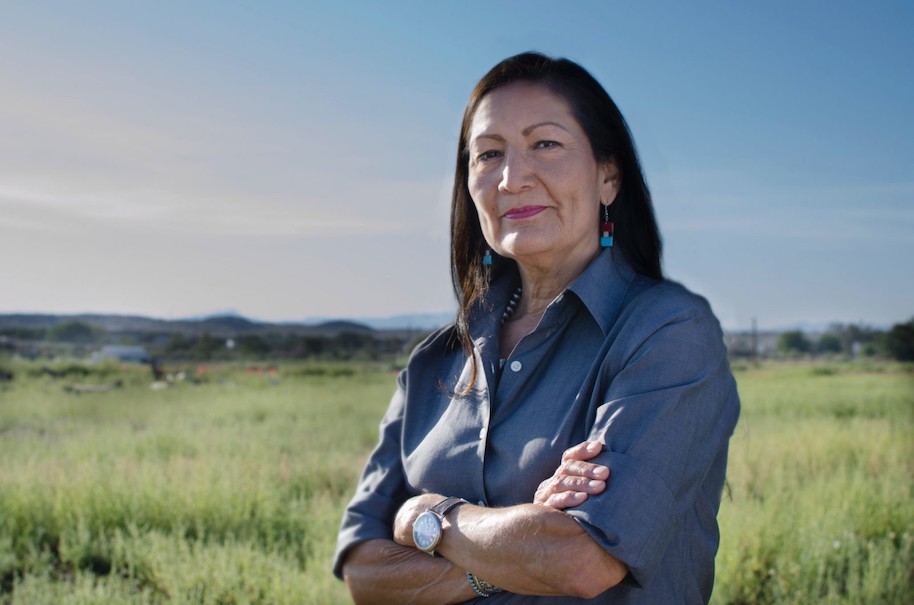
With two key Republican women in the Senate now pledging to support Deb Haaland for Interior Secretary, her nomination is almost certain when it reaches the full Senate.
Alaska Senator Lisa Murkowski will cross party lines and buck powerful energy industry interests to support Haaland.
Susan Collins, a Republican Senator from Maine, will also vote for Haaland in the full Senate.
The last hurdle before that Senate vote was approval by the Senate’s Energy and Natural Resources Committee. The committee held two days of hearings last week but adjourned without action.
This morning, Senators reconvened to debate and vote.
All eyes were on West Virginia Senator Joe Manchin, a Democrat from a coal industry state, and Alaska’s Lisa Murkowski, a Republican who had been heavily lobbied by energy interests to oppose Haaland.
As chairman, Manchin went first.
Then came Republicans. Predictably, Sen. Barrasso sided with energy interests against her. But Murkowski, representing a state with a high Native American population, seemed swayed by the historic nature of the nomination of the country’s first Native American cabinet official.
New Mexico’s Martin Heinrich got the last word:
By a vote of 11-9, Senators voted “favorably” on the confirmation of Haaland, sending her nomination to the full Senate for a vote sometime soon.
Who Voted for Haaland?
All 10 Senate Energy Committee Democrats, plus Republican Lisa Murkowski. Yes votes include Senator Martin Heinrich and Senators Manchin, Wyden, Cantwell, Sanders, Hirono, King, Cortez Masto, Kelly and Hickenlooper.
Who Voted Against Haaland?
9 Republicans. Senators Barrasso, Risch, Lee, Daines, Hoeven, Lankford, Cassidy, Hyde-Smith and Marshall.
What Happens Next?
Haaland’s confirmation heads to the full Senate where it will be scheduled for a vote. But don’t look for this to happen quickly.
Haaland, still a sitting member of the U.S. House of Representatives, is an important Democratic vote for Biden’s agenda and Speaker Pelosi is working to pass a long list of Democratic priorities for in Biden’s first 100 days. In other words, look for Haaland’s final vote to be scheduled sometime next month.
Indigenous Peoples’ Human Rights as a Minimum Standard for Corporate Practice
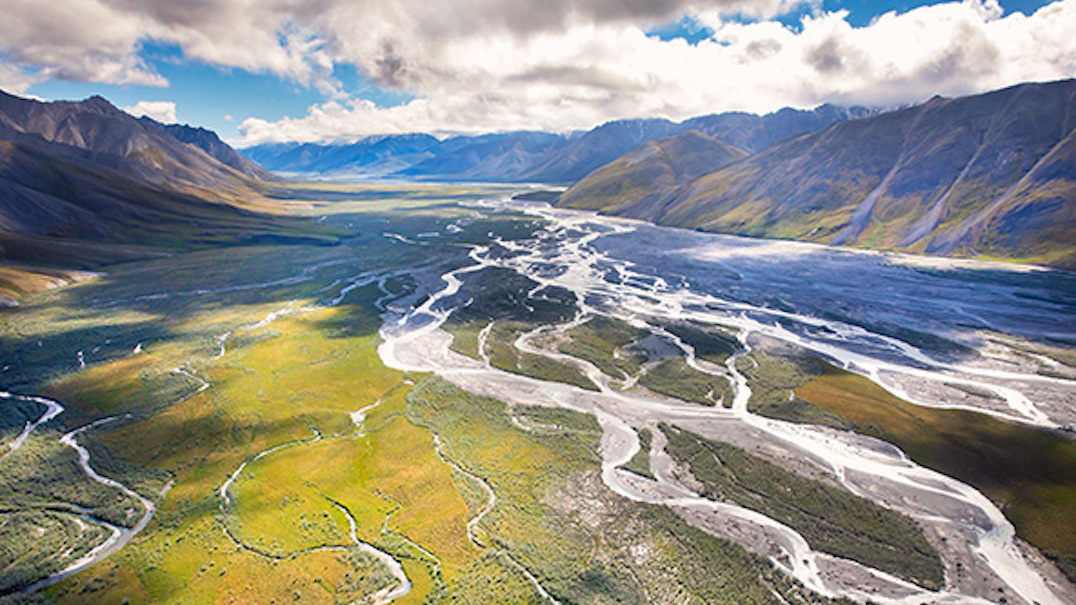
By building strategic alliances with investors and shareholders, Indigenous Peoples are proactively protecting their rights by urging corporate respect of those rights in routine operations.
When the United Nations adopted the Declaration on the Rights of Indigenous Peoples in 2007, it was the first time Indigenous Peoples’ rights were widely affirmed on a global scale. The Declaration contemplated not only the inextricable connection between Indigenous Peoples’ livelihoods, culture, and land, but also their collective rights to decision-making and self-determination. Countries have integrated those rights into their domestic policies and laws at different levels, but the Declaration provides a minimum standard under which Indigenous Peoples’ rights can be considered. Moreover, Indigenous Peoples worldwide view the Declaration as the authoritative enumeration of their rights that guides their interactions with government or with business.
In general, corporate consideration of Indigenous Peoples and their human rights is often peripheral to business operations and, when considered, are generally relegated to an environmental compliance process. This means that the impacts of development on Indigenous communities are often only addressed during project implementation, or only after a violation of their rights has occurred. Such an approach detrimentally narrows the focus to remedy of harms already done rather than preventing violations at the outset. Further, when tribes and Native people have used the courts to realize their rights under the Declaration, the relief is too often reactive to damages or human rights violations that have already occurred. When sacred lands or objects have already been destroyed, for example, there is no remedy even if a court case is ultimately won.
Since transnational corporations affect the human rights of peoples around the world in their ordinary course of business, in 2011 the United Nations set forth the Guiding Principles on Business and Human Rights as a three-part framework to address human rights impacts. The framework includes: 1) States’ responsibility to protect human rights, 2) the corporate responsibility to respect human rights, and 3) access to remedy for affected communities. Businesses have a responsibility to assess where their operations intersect with international human rights standards, and to do so with an eye towards prevention of human rights abuses. The Guiding Principles point to the significant overlap between a corporate director’s fiduciary duty to shareholders to manage the business with due care, and the director’s role to adequately assess the risks of corporate operations along a number of criteria such as financial risk, environmental risk, social risk, and human rights risk. This framework runs parallel to the decade-long shift in the corporate sector towards the adoption of broader environmental, social, and governance criteria (ESG), as well as the adoption of policies to respect human and environmental rights as a matter of business.
Building Alliances
As part of the growing ESG movement, Indigenous Peoples have realized the cumulative power of building strategic alliances with concerned investors as an effective means to proactively protect their rights, as well as to integrate respect for their rights into corporate practice. These investors reach other impact-oriented investors to build coalitions that can elevate Indigenous leaders in strategies such as letter writing, speaking at industry events, direct dialogue with banks and corporations, and filing shareholder proposals. Together, these coalitions of investors and Indigenous Peoples bring their shared interest into focus by leveraging assets under management to influence corporate decision-making.
Indigenous Peoples have pioneered the use of shareholder advocacy as a strong tool to integrate respect for human rights into corporate practice, successfully eradicating racist branding and addressing cultural appropriation. For example, the Interfaith Center on Corporate Responsibility organized 800 investors to call on Liz Claiborne to retire the “Crazy Horse” brand; in 2007, the label was discontinued. Similarly, after long engagement around the Washington NFL team’s racist logo and mascot, in June 2020 investors—representing more than $620 billion in assets—sent a letter to corporate sponsors Nike, PepsiCo, and FedEx urging them to make good on their commitments to eradicate racism by pressuring the team to change its name. A letter with nearly 1,500 signatories of Native organizations and leaders was sent to show the wide consensus for change in Indian Country. By July 13, the team had retired the name and logo.
These successes are compounding, and shareholder advocacy is becoming an increasingly important strategy to protect Indigenous lands, territories, and resources from extractive development. Core to this engagement to build preventative frameworks is advocating for Indigenous Peoples’ right to free, prior, and informed consent (FPIC) over the development of their lands, territories, and resources. FPIC is of paramount importance because it is a critical safeguard of other rights, as true implementation of FPIC allows Indigenous leadership the opportunity to meaningfully choose what type of development may occur in their communities. Because the right to set self-determined development priorities needs to be recognized prior to project finance or project implementation, Indigenous Peoples are now leveraging early opportunities for shareholder advocacy and corporate engagement to influence business behavior towards optimal operationalization of FPIC.
Standing Rock Sioux Tribe and the Dakota Access Pipeline
Although Indigenous Peoples and investors have come together frequently over the last decade, few examples are as visible and powerful as what occurred during the Standing Rock Sioux Tribe’s opposition to construction of the Dakota Access Pipeline (DAPL) on their treaty territory. The Tribe had expressed their desire to reroute the pipeline away from their lands as early as 2014, filed a legal case in 2016 directly opposing the route as planned, and expressed to the media their position that the pipeline violated their treaty rights. When DAPL’s parent company—Energy Transfer Partners—continued construction, decimating objects with cultural and spiritual value to tribes across the Great Plains, the clear disregard for the Tribes’ resources and concerns led to significant social unrest. Indigenous Peoples and allies from around the world gathered on the banks of the Cannonball River to physically protest construction of the pipeline. In fact, the #NoDAPL movement swelled to 15,000 people at its apex and resulted in conflict, arrests and further human rights violations.
In parallel to legal and international advocacy measures, the Standing Rock Sioux Tribe activated a shareholder advocacy campaign targeted towards financial institutions funding pipeline construction. The Tribe, supported by a significant coalition of investors, sent a letter representing over $685 billion assets under management—the total market value managed on behalf of the investors’ clients—that elevated to those institutions the real-time impacts of corporate actors’ failure to consider human rights during construction. After meeting with multiple institutions over the course of the campaign, several European banks pulled their commitments from the pipeline.
The Standing Rock Sioux Tribe’s corporate engagement campaign put the rights of Indigenous Peoples on the radar as a material consideration for financial institutions. In 2018, First Peoples Worldwide used publicly available data to study whether the social and human rights risks attendant to DAPL manifested in financial losses. The study found that, though initially estimated to cost $3.8 billion, the pipeline cost more than $12 billion by the time it was operational in June 2017, losses accumulated from the long delays in construction due to social unrest and legal filings. Energy Transfer Partners’ stock price significantly underperformed relative to market expectations during the event study period, and it experienced a long-term decline in value that persisted after the project was completed. In fact, from August 2016 to September 2018—while the S&P 500 increased by nearly 35 percent—ETP’s stock declined by almost 20 percent.
While the case study does not attribute this underperformance exclusively to social pressure, the early failure to respect the human rights of the affected Indigenous Peoples led to social protests and pressure, which led to the delays that ultimately cost the company and associated financial institutions billions of dollars. Given these financial losses, this case study demonstrates the need for corporate directors and shareholders to understand, review, and incorporate respect for Indigenous Peoples into their business operations as a matter of fiduciary duty, if not as a matter of sustainable finance.
Implementing Shareholder Advocacy in the Arctic
More recently, the Gwich’in Steering Committee has leveraged shareholder advocacy to create new momentum to protect the Coastal Plain of the Arctic Refuge, which is currently under direct threat of development by oil and gas companies. The Coastal Plain is sacred for the Gwich’in and other Alaskan Natives – the Gwich’in call it “Iizhik Gwats’an Gwandaii Goodlit” (The Sacred Place Where Life Begins). In 1988, Gwich’in Elders and Chiefs gathered for the first time in over 150 years and formed the Gwich’in Steering Committee (GSC) to act as the unified voice to protect their ancestral lands. Since then, the Gwich’in people have used every mechanism possible to protect the Coastal Plain from oil and gas development and recently have engaged with corporate and financial institutions in those efforts. In 2019, the GSC met with multiple financial institutions to urge them to ban financing for oil and gas development in the Arctic Refuge. At the meetings, representatives from the banks recalled meeting with Standing Rock Sioux tribal leaders in 2016 and indicated that those meetings continue to influence their policies.
To date, more than 30 international financial institutions have adopted policies that exclude project-level financing for oil and gas development in the Arctic. Significantly, since the meetings in 2019, all six major US banks and all major Canadian banks released updates to their policies banning project-level financing for fossil fuel development in the Refuge, and lease sales performed dramatically below expectations, with no major energy companies participating.
This strategy is increasingly important as incursions continue unabated around the world affecting Indigenous communities in Russia, the Amazon, Australia, and Africa, and, in the US, in Minnesota, Arizona, and southern Alaska, among so many more.
Forward-Looking Accountability
Engaging with investors and shareholders to elevate the importance of Indigenous Peoples’ rights is an increasingly critical avenue for advocacy and change, especially as companies and investors seek additional means to activate their own values aligning with social, environmental, and racial justice. Shareholder advocacy creates accountability not only between a boardroom and the impacts of business in Indigenous communities but between a corporation’s own policies and actions. Through understanding and incorporating these rights at every stage of decision-making—especially the initial stages—businesses can pave the way for a more integrated respect of Indigenous Peoples’ rights, one that is forward-looking instead of reactionary. In this way, centering the rights of Indigenous Peoples is an imperative for companies who are seeking the best means not only to prevent human right violations but to activate greater respect for Indigenous Peoples by aligning their operations with Indigenous self-determination and well-being.